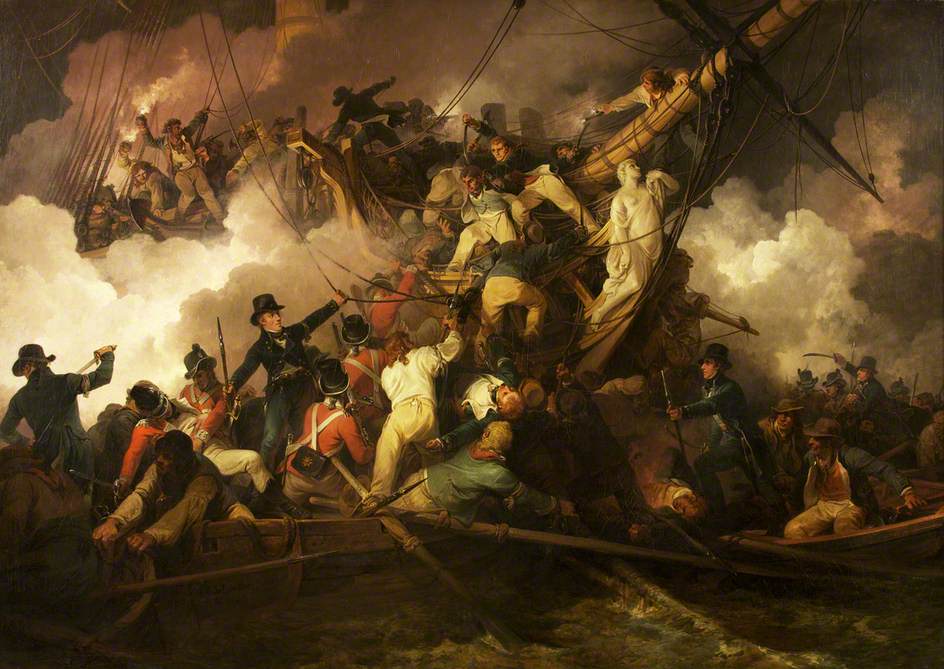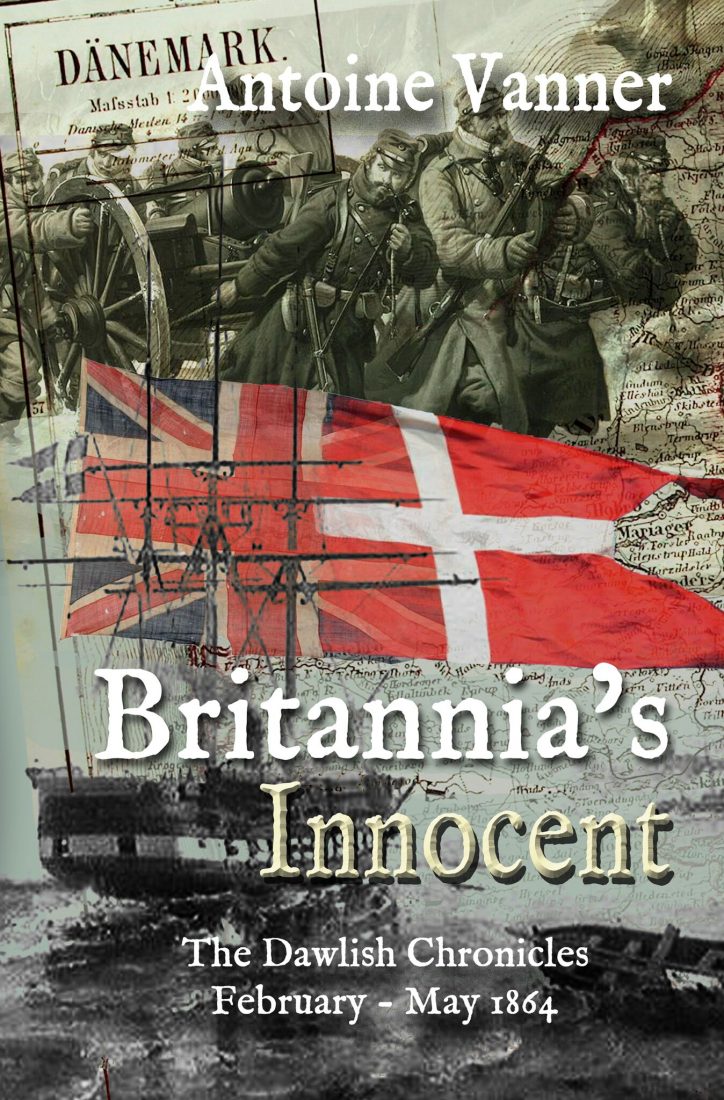
Privateer Action off Peru 1801
 |
|
The sort of vessel often used for privateering service
Danish Brig by Antoine Roux (1765-1835)
|
One outstanding example of a privateer in action in the Napoleonic period occurred in 1801, off Callao, the main port of what was then the Spanish colony of Peru, when Spain was still in alliance with France against Britain. This case was especially notable in that the privateer was prepared not just to dart in and out to capture a prize, but to engage in battle with a much more powerful ship.
The Chance, commanded by a Captain White and with a crew of 94, was heavily armed for a privateer as she carried 16 guns, most of which appear to have been 12 and 6-pounder carronades. The fact that she was operating off the west coast of South America, far from any British-controlled port, was in itself confirmation of White’s Intrepid spirit. In the Chance’s favour however was that this very fact could lead to complacency by Spanish vessels that an enemy raider was not a likely threat.
Towards nightfall on 29th August 1801 the Chance approached Callao and encountered a large Spanish trader. Captain White ordered Spanish colours to be run up – a ruse-de-guerre internationally approved as legal until fire would be opened, when British colours must replace them – and he manoeuvred so as to keep the Chance between the trader and Callao itself. By ten o’clock the vessels were within pistol shot and White hailed the Spaniard. Still unsuspecting, and perhaps also with suspicion dulled by the Chance being so much smaller, the Spanish vessel replied that she was the Amiable Maria but apparently did not indicate that she was anything but a trading vessel. White responded by running up British colours and opening fire – a manoeuvre that was calculated to intimidate any innocent trader into immediate surrender. A boat was simultaneously dropped to carry the Chance’s second lieutenant and a boarding party to take possession.
 |
|
An action perhaps similar as regards sizes to the Chance and Maria Amiable contest
The Will of Liverpool under attack by a French privateer 1804 – by Robert Salmon (1775-1851)
|
White had miscalculated – the Amiable Maria was a naval vessel, armed with 18 and 24-pounder weapons – and after the initial shock the Spanish commander brought them into action. White’s stark alternatives were now to fight or to fly, and flight might have been considered the more logical choice. In a straight fire-fight the Chance’s puny armament would be no match for the enemy’s heavier battery and it was likely that she would be pounded to a wreck in short order. The only hope lay in boarding. White accordingly closed with the Amiable Maria in an attempt to run the Chance’s bowsprit over the enemy’s stern to provide a means of crossing. The wind was so light however that the Chance fell away, exposing her stern to an enemy broadside that dismounted several of her guns and killed one of the officers. Undismayed, White closed again and this time managed to run the bowsprit over the Amiable Maria’s quarter. Men swarmed across and bound the bowsprit to the enemy’s mizzen mast, so locking both ships together.

In “The cutting-out of the Chevrette, 1801″, Philippe-Jacques de Loutherbourg (1740 -1812), conveys perhaps best ever depiction of the violence and desperation of a boarding action
At this remove in time it is difficult to imagine just how savage a boarding action could be. In a novel it may occupy a few pages, in a movie some minutes, but the reality of hacking, stabbing and shooting in a small area sometimes lasted for hours. The Chance and the Maria Amiable might be locked together but the Spaniards rallied and drove the boarders back on to the bowsprit. Captain White seems to have been in the thick of the action at this point and he managed, sword in hand, to beat back the defenders and get his own men across to the Spanish poop. They attempted to press forward and every inch was contested by the Maria Amiable’s crew in a struggle that lasted forty-five minutes. The Spanish captain and his men were at last forced back to the forecastle, where they began to drag the bow guns around, loaded with grape and canister, to blast sternwards. Had this succeeded then the Maria Amiable might have been saved but at this critical moment the Spanish captain was disabled. He was carried below and his men rushed after. What must have been the worst part of the action now followed, a murderous close-quarter battle on the lower deck and in the cabins that finally resulted in only 86 of the 220-man Spanish crew surviving when they finally surrendered. The decks were littered with corpses and wounded and an added horror was the screaming of a Spanish lady who had been a passenger on board, and whose baby had been cut in half by a roundshot, although she herself was uninjured.
 |
|
Another battle between unequally-matched ships: East Indiaman Kent under attack by French Confiance 1800
Painting by Ambroise Louis Garneray (1783-1857)
|
The two ships, still locked together had drifted to within four miles of the port. The Maria Amiable’s shrouds and braces had been badly damaged but the masts were apparently still standing and it was possible, as a breeze sprung up, to take her out to sea. The disparity in casualties seems extreme, if a 19th Century account of the action is to be believed, with the Chance allegedly losing only one officer killed and three officers and two seamen badly wounded. Surprise and the apparent unpreparedness of the Spanish crew, may have been significant factors in this.
The action had occurred in sight of the shore and the Spanish Viceroy of Lima was outraged. A small warship, the Limeňo, mounting 18 long 9-pounders and 12 4-pounders, was sent after the Chance with a bounty offered for every man taken, dead or alive. Though the Chance’s crew was reduced to 50 through casualties and provision of a prize-crew for the Maria Amiable, White decided to accept combat. He again closed to pistol shot – at which his carronades were likely to be more effective than the enemy’s long nines and the two ships, more equally matched than in Chance’s earlier action, commenced a running firefight yard-arm to yard-arm. It lasted two and three-quarter hours before the Limeňo surrendered. She had suffered fourteen killed and seven wounded to the Chance’s two killed and one wounded.
We leave Captain White with his battered Chance and two Spanish prizes off the South American coast. What happened afterwards? The 19th Century account I have read makes no further mention of the man or of his ships. One hungers to know more about a man who, had he been a Royal Navy officer, would most certainly have had a stellar career thereafter.
Britannia’s Innocent
What links war in Denmark in 1864 with the American Civil War?
Click as below for details:
 1864 – Political folly has brought war upon Denmark. Lacking allies, the country is invaded by the forces of military superpowers Prussia and Austria. Cut off from the main Danish Army, and refusing to use the word ‘retreat’, a resolute commander withdraws northwards. Harried by Austrian cavalry, his forces plod through snow, sleet and mud, their determination not to be defeated increasing with each weary step . . .
1864 – Political folly has brought war upon Denmark. Lacking allies, the country is invaded by the forces of military superpowers Prussia and Austria. Cut off from the main Danish Army, and refusing to use the word ‘retreat’, a resolute commander withdraws northwards. Harried by Austrian cavalry, his forces plod through snow, sleet and mud, their determination not to be defeated increasing with each weary step . . .
Across the Atlantic, civil war rages. It is fought not only on American soil but also on the world’s oceans, as Confederate commerce raiders ravage Union merchant shipping as far away as the East Indies. And now a new raider, a powerful modern ironclad, is nearing completion in a British shipyard. But funds are lacking to pay for her armament and the Union government is pressing Britain to prevent her sailing . . .
But Denmark is not wholly without sympathisers. Britain’s heir to the throne is married to a Danish princess. With his covert backing, British volunteers are ready to fight for the Danes. And the Confederacy is willing to lease the new raider to Denmark for two months if she can be armed as payment, although the Union government is determined to see her sunk . . .
Just returned from Royal Navy service in the West Indies, the young Nicholas Dawlish is induced to volunteer and is plunged into the horrors of a siege, shore-bombardment, raiding and battle in the cold North Sea – notwithstanding divided loyalties . . .
In other books of the Dawlish Chronicles series, Dawlish is met as an experienced and resourceful officer, but in 1864 he is still an innocent. But he will need to learn fast . . .
Below are the elevenDawlish Chronicles novels published to date, shown in chronological order. All can be read as “stand-alones”. Click on the banner for more information or on the “BOOKS” tab above. All are aailable in Paperback or Kindle format and can read at no extra charge by Kindle Unlimited or Kindle Prime Subscribers.
Six free short-stories are available for download to your Kindle. Access them by registering for the Dawlish Chronicles mailing list – just click on the banner below. You’ll be kept updated on new books and will receive other free stories at intervals.





 1864 – Political folly has brought war upon Denmark. Lacking allies, the country is invaded by the forces of military superpowers Prussia and Austria. Cut off from the main Danish Army, and refusing to use the word ‘retreat’, a resolute commander withdraws northwards. Harried by Austrian cavalry, his forces plod through snow, sleet and mud, their determination not to be defeated increasing with each weary step . . .
1864 – Political folly has brought war upon Denmark. Lacking allies, the country is invaded by the forces of military superpowers Prussia and Austria. Cut off from the main Danish Army, and refusing to use the word ‘retreat’, a resolute commander withdraws northwards. Harried by Austrian cavalry, his forces plod through snow, sleet and mud, their determination not to be defeated increasing with each weary step . . .


